
Davie County is a county located in the U.S. state of North Carolina. As of the 2020 census, the population was 42,712. Its county seat is Mocksville.

Mocksville is a town in Davie County, North Carolina, United States. The population was 5,900 at the 2020 census. I-40 leads west to Statesville and Hickory, and east to Winston-Salem and Greensboro. Route 64 heads east to Lexington, and west towards Statesville and Taylorsville. It is the county seat of Davie County.
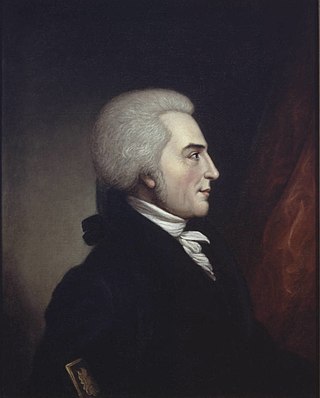
William Richardson Davie was an American statesman, politician, military general, Founding Father of the United States who served as the 10th Governor of North Carolina from 1798 to 1799. A member of the Federalist Party, Davie also served as a delegate to the Constitutional Convention as a representative of North Carolina. He is also one of the key founders of the University of North Carolina.
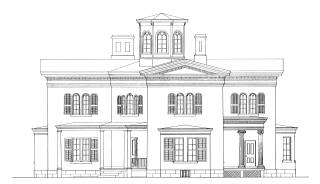
Cooleemee, also known as the Cooleemee Plantation House, is a house located between Mocksville and Lexington, North Carolina, at the terminus of SR 1812 on the Yadkin River in Davie County, North Carolina. It is a U.S. National Historic Landmark, designated in 1978 for its architecture.
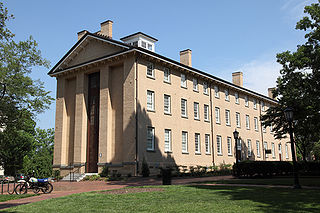
Old East is a residence hall located at the north part of campus in University of North Carolina at Chapel Hill. Built in 1793 by slave labor, it became the first state university building in the United States. The Wren Building at the College of William & Mary in Williamsburg, Virginia, was built in 1695, but William and Mary did not become a public university until 1906.
Advance is an unincorporated community and census-designated place (CDP) in Davie County, North Carolina, United States. It is seventy-five miles northeast of Charlotte. As of the 2010 census it had a population of 1,138. It is located along North Carolina Highway 801 just south of Bermuda Run. Advance is part of the Piedmont Triad region of North Carolina.

The Hinton Rowan Helper House is a historic house on United States Route 64 outside Mocksville, Davie County, North Carolina. Built on land that once belonged to Daniel Boone, it was the childhood and early adult home of Hinton Rowan Helper (1829-1909) whose The Impending Crisis of the South was an influential antislavery work that inflamed tensions in 1860. The house was added to the National Register of Historic Places and declared a National Historic Landmark in 1973.

The Lancaster County Jail is a historic former jail building at 208 West Gay Street. Built in 1823, it is a virtually unaltered work of the noted early American architect Robert Mills, and reflects innovative changes in jail design promoted by him. It is individually listed on the National Register of Historic Places, and was declared a National Historic Landmark in 1973.

Lancaster County Courthouse is a historic courthouse in Lancaster, South Carolina. Built in 1828, it has been in continuous use since then. It was designated a National Historic Landmark in 1973, as a possible work of Robert Mills, an important American architect of the first half of the 19th century. It also has the distinction of being the site of the last witch trials to take place in the United States.

This list includes properties and districts listed on the National Register of Historic Places in Caswell County, North Carolina. Click the "Map of all coordinates" link to the right to view an online map of all properties and districts with latitude and longitude coordinates in the table below.

This list includes properties and districts listed on the National Register of Historic Places in Davie County, North Carolina. Click the "Map of all coordinates" link to the right to view a Google map of all properties and districts with latitude and longitude coordinates in the table below.

Halifax Historic District is a national historic district located at Halifax, Halifax County, North Carolina, US that was listed on the National Register of Historic Places in 1970. It includes several buildings that are individually listed on the National Register. Halifax was the site of the signing of the Halifax Resolves on April 12, 1776, a set of resolutions of the North Carolina Provincial Congress which led to the United States Declaration of Independence gaining the support of North Carolina's delegates to the Second Continental Congress in that year.

The William R. Davie House, on Norman St. in Halifax, Halifax County, North Carolina, is a historic house with significance dating from 1783. William R. Davie (1754–1820) was born in England. He was a Founding Father of the United States and a patriot officer of mounted troops in the American Revolution who attended the Constitutional Convention from North Carolina, served as governor of North Carolina, served as a special ambassador to France during the XYZ Affair, and served in the North Carolina legislature. The house, also known as Loretta, was built on five acres that Davie bought in 1783. It was built starting probably in about 1785. It is a large two-story, frame side-hall plan house beneath a gable roof. It has a two-story wing raised from an earlier one-story wing and a number of one-story rear additions. The house is sheathed in weatherboard and rests on a brick foundation.

The (Old) Orangeburg County Jail, also known as The Pink Palace, is a historic jail located at Orangeburg, Orangeburg County, South Carolina. It was built between 1857 and 1860, and is a two-story, rectangular, cement-covered brick building in the Late Gothic Revival style. It features a crenellated main tower and corner turrets. General William Tecumseh Sherman’s troops burned the building in February 1865; it was subsequently restored.

Davie County Courthouse is a historic courthouse located at Mocksville, Davie County, North Carolina. It was built in 1909, and is a two-story reinforced concrete and tan brick structure in the Classical Revival style. It features a tetrastyle Corinthian order in antis portico which shelters the center front entrance, with an ornate square clock cupola. The building was restored and renovated following a fire in 1916. The interior was renovated in 1971.
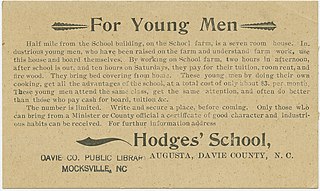
Hodges Business College, also known as Hodges School, is a historic school building located near Mocksville, Davie County, North Carolina. It was built in 1894, and is a two-story, rectangular, Gothic Revival-style brick building. It features multiple Gothic-arched window openings and front entrance. The building housed a school into the 1910s, then was converted to tenant house, and after 1936 used for storage. The building was converted to a residence in the 1990s.
George E. Barnhardt House is a historic house located near Mocksville, Davie County, North Carolina. It is locally significant as a rare surviving example of a post-American Civil War brick farmhouse in Davie County.

Downtown Mocksville Historic District is a national historic district located at Mocksville, Davie County, North Carolina. The district encompasses 21 contributing buildings and 1 contributing object in the central business district of Mocksville. It primarily includes residential and commercial buildings with notable examples of Classical Revival and Beaux-Arts style architecture. The district includes the previously listed Davie County Courthouse. Other notable buildings include the Davie County Jail (1916), (former) C. C. Sanford Sons Store (1937), (former) J. T. Baity/Anderson Store, (former) Meroney Hardware Company Building (1922-1924), Sanford Brothers Building (1927), (former) Southern Bank &. Trust Company Building (1923), (former) Princess Theatre, J. T. Angell Building (1910), Horn Service Station, (former) Kurfees and Ward Pure Oil Station, (former) Meroney Filling Station, and Johnstone Office Building (1939).
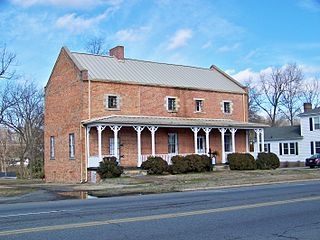
Dallas Historic District is a national historic district located at Dallas, Gaston County, North Carolina. It encompasses eight contributing buildings surrounding the courthouse square and dated between about 1840 and 1900. Dallas served as the county seat of Gaston County from 1847 to 1911. They are the Greek Revival style old Gaston County Courthouse, which now functions as the Dallas Town Hall; the county jail; the Hoffman Hotel; the Rhyne Store; the Smyre-Pasour House; the Matthews Hotel; the Late Victorian style Wilson-Spargo House; and the Setzer General Store.

East Broad Street–Davie Avenue Historic District is a national historic district located at Statesville, Iredell County, North Carolina. It encompasses 65 contributing buildings in a predominantly residential section of Statesville. The district includes notable examples of Late Victorian architecture and were mainly built between about 1880 and 1930. Notable buildings include the Elma Apartments building, Matt-Simons House, J. S. Ramsey House, and Major H. L. Allison House.



















